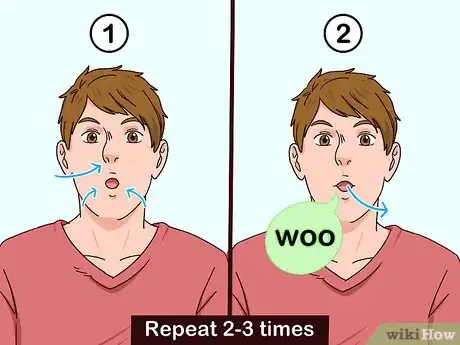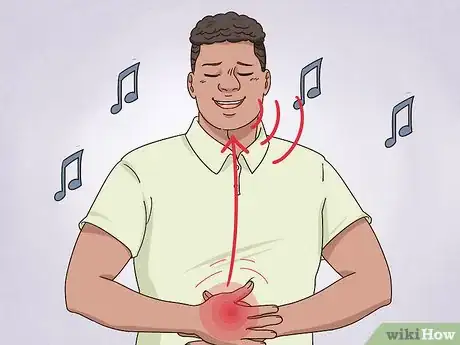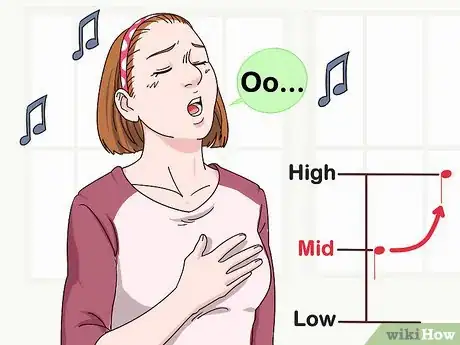This article was co-authored by Annabeth Novitzki and by wikiHow staff writer, Amber Crain. Annabeth Novitzki is a Private Music Teacher in Austin, Texas. She received her BFA in Vocal Performance from Carnegie Mellon University in 2004 and her Master of Music in Vocal Performance from the University of Memphis in 2012. She has been teaching music lessons since 2004.
wikiHow marks an article as reader-approved once it receives enough positive feedback. This article received 25 testimonials and 84% of readers who voted found it helpful, earning it our reader-approved status.
This article has been viewed 1,995,771 times.
Every singer wants to increase their vocal range, and hitting high notes is the most impressive feat of all. No one is born being able to sing the highest notes perfectly, though! Vocal cords need exercise, just like other muscles, to get stronger. Start by learning how to relax your muscles. Then get your voice warmed up and practice specific exercises to help you increase your range.
Steps
Relaxing Your Muscles
-
1Take slow, relaxed breaths to release tension. Your breathing needs to be relaxed to hit high notes. Otherwise, that tension goes right into your voice. Take a normal breath in, then exhale. Keep your breath slow and even.
- Relax your shoulders, neck and chest as you continue to breathe in and out. This helps release tension from those areas.[1]
-
2Massage your face and jaw muscles to release jaw tension. Put the heels of your hands on either side of your face, right below your cheekbones. Push them gently into your cheeks, then move them slowly down into your jaws. Let your mouth hang open a little bit. Repeat this several times.[2]Advertisement
-
3Do some neck and shoulder rolls to loosen up the muscles. Slowly roll your neck from side to side. Once your neck feels stretched out, roll your shoulders gently and slowly, backward and forward. Then let your arms hang loosely at your sides.[3]
- Try to keep your arms loose as you practice. Avoid the urge to ball up your fists or strain your arm muscles when trying to hit high notes.
Warming up Your Voice
-
1Use a personal humidifier before and after singing. A personal humidifier brings warm, moist air to your vocal cords. Using one before and after each practice session or performance will help keep your vocal cords in good shape.
-
2Drink a glass of warm water to relax throat muscles. It also helps hydrate the vocal chords, allowing you to reach the higher registers. Add honey to your water to decrease and/or prevent their throat from swelling.
- Don't drink ice water, caffeine or milk before warming up your voice. These can have a negative effect on your singing voice.
-
3Trill with your lips to warm them up. Press your lips together loosely. Release air through your mouth in a steady stream, so that your lips vibrate and make a raspberry sound. Move on to doing this with “h” sounds, maintaining a steady voice as you move the air past your lips.
- Once you’ve got that, try it on “b” sounds. Then continue doing “b” sounds, but go up and down the scales.[4]
- Lip trills help you strengthen your breath control while reducing pressure on your vocal cords.
-
4Stretch out your vocal chords with “sirens.” Round your mouth into an “o” position and inhale. It helps to imagine you’re sucking down a spaghetti noodle! When you exhale, make a “woo” sound. Keep your “woo” steady and repeat this 2-3 more times.
- After that, start going up and down the scales as you “woo.”[5]
-
5Do two-octave scales to warm up for higher notes. Starting in a low pitch, sing a “me” sound as you go up the scale. Reverse and go down the scale as you sing an “ee” sound. Keep going, up and down, gently increasing your range each time.
Developing Your Range
-
1Breathe from your abdomen for a stronger sound. As a singer, you’ve probably heard this advice countless times. It’s important, though! It helps you hit and maintain high notes, and helps to relax your muscles.[8]
- When you inhale, your stomach should rise first, followed by your chest.
- If you have trouble with this, try putting your hand on your abdomen as you breathe. It’ll remind you to focus on breathing from that area.
- High notes require a ton of breath control, so sing from your diaphragm and practice controlling the amount of air you use to support your vocal cords.[9]
-
2Start in the middle of your range and sing higher and higher. This can be a continuation of the “oo” and “ee” sounds you used in warm-up. Once you get your voice up into the high register that you want, open up those vowel sounds to sound more like “oh” and “uh.”[10]
- As you practice this over time, you’ll notice that the higher notes are getting easier and easier to reach.
- Don't neglect your lower range, though. Practising low notes helps strengthen your vocal cords so you can hit the high notes as well.
-
3Experiment with your vowel sounds. Each voice has certain vowels that work best when singing high notes. Others are harder to hit. You should experiment to determine which vowels work and sound best for you. Once you have an idea of which vowel works best, modify (gradually) towards that vowel as you ascend the scale.
- For example, you might have a hard time hitting a long "e" (like in "meet"), but you can easily hit a short "i." You could modify the long "e" in "meet" by singing "mitt" and subtly adjusting the "i" into the long "e" as you get higher.[11]
-
4Start putting a consonant in front of vowels. Consonants, like a hard “g,” can help you get better at cord closure. After practicing vowels for a while, put a hard “g” in front of them. This helps you maintain a steady sound by keeping your vocal cords vibrating steadily.[12]
- Also work on consonants like “m” and “n” in front of vowels.
- Cord closure is when your vocal cords come together to create a sound. If they aren’t “closed” all the way, it's difficult to maintain steady air flow.[13]
-
5Sing the word "yawn" on the high notes to get your mouth in position. When rehearsing, never hesitate to sing the word "yawn" for one of those notes in your upper range. When you sing that word, it positions your mouth and throat in exactly the right place to hit high notes. This is a handy trick to help you get used to the proper mouth positioning; don't do this during a performance, though!
-
6Keep your sounds smooth and connected. Steady airflow allows you to hit and maintain your high notes. As you work on your range, keep your breath flowing in and out steadily. Strive to make smooth, connected sounds.[14]
- Think about the whole phrase that includes the high note, then support your voice continuously from the beginning. This connects the high note to the notes before it.
- Forcing out air on certain notes can strain your throat and voice.
-
7Cool down after each session to prevent injury. Working on high notes is hard on your vocal cords. To keep those muscles operating well, cool them down after you work them out. To do this, hum gently while making an “m” sound. Move up and down the scales as you make the “m” sound.[15]
- Focus on how the sound feels coming out of your lips. It will vibrate and tickle a little bit!
-
8Give your vocal cords a rest for 30 minutes after each session. It's important to let your voice rest and recover after working on high notes. Spend 30 minutes in total silence--no singing, talking, or humming--after each singing session to give your vocal cords a full rest.
Expert Q&A
Did you know you can get expert answers for this article?
Unlock expert answers by supporting wikiHow
-
QuestionHow can I sing high notes loudly?
 Annabeth NovitzkiAnnabeth Novitzki is a Private Music Teacher in Austin, Texas. She received her BFA in Vocal Performance from Carnegie Mellon University in 2004 and her Master of Music in Vocal Performance from the University of Memphis in 2012. She has been teaching music lessons since 2004.
Annabeth NovitzkiAnnabeth Novitzki is a Private Music Teacher in Austin, Texas. She received her BFA in Vocal Performance from Carnegie Mellon University in 2004 and her Master of Music in Vocal Performance from the University of Memphis in 2012. She has been teaching music lessons since 2004.
Music Teacher
-
QuestionWhat is the highest vocal note?
 Annabeth NovitzkiAnnabeth Novitzki is a Private Music Teacher in Austin, Texas. She received her BFA in Vocal Performance from Carnegie Mellon University in 2004 and her Master of Music in Vocal Performance from the University of Memphis in 2012. She has been teaching music lessons since 2004.
Annabeth NovitzkiAnnabeth Novitzki is a Private Music Teacher in Austin, Texas. She received her BFA in Vocal Performance from Carnegie Mellon University in 2004 and her Master of Music in Vocal Performance from the University of Memphis in 2012. She has been teaching music lessons since 2004.
Music Teacher
-
QuestionCan you learn to sing higher notes?
 Annabeth NovitzkiAnnabeth Novitzki is a Private Music Teacher in Austin, Texas. She received her BFA in Vocal Performance from Carnegie Mellon University in 2004 and her Master of Music in Vocal Performance from the University of Memphis in 2012. She has been teaching music lessons since 2004.
Annabeth NovitzkiAnnabeth Novitzki is a Private Music Teacher in Austin, Texas. She received her BFA in Vocal Performance from Carnegie Mellon University in 2004 and her Master of Music in Vocal Performance from the University of Memphis in 2012. She has been teaching music lessons since 2004.
Music Teacher
Warnings
- If you feel any pain in your throat, stop singing and rest. This could mean that you're straining your voice.⧼thumbs_response⧽
- Do not sing when you have a sore throat. You're more likely to decrease your range than increase it.⧼thumbs_response⧽
- Be sure to warm up your voice to get the best results and prevent injury.⧼thumbs_response⧽
References
- ↑ http://www.entnet.org/content/vocal-warmup-put-your-best-voice-forward
- ↑ http://www.entnet.org/content/vocal-warmup-put-your-best-voice-forward
- ↑ http://howtobeabettersinger.net/how-to-sing-high-notes-tips-and-tricks/
- ↑ http://www.entnet.org/content/vocal-warmup-put-your-best-voice-forward
- ↑ http://www.entnet.org/content/vocal-warmup-put-your-best-voice-forward
- ↑ http://www.entnet.org/content/vocal-warmup-put-your-best-voice-forward
- ↑ http://howtobeabettersinger.net/how-to-sing-high-notes-tips-and-tricks/
- ↑ http://www.entnet.org/content/vocal-warmup-put-your-best-voice-forward
- ↑ https://www.nats.org/_Library/Kennedy_JOS_Files_2013/JOS-058-1-2001-061.pdf
- ↑ https://www.backstage.com/advice-for-actors/singing/hitting-those-high-notes/
- ↑ http://www.singwise.com/cgi-bin/main.pl?section=articles&doc=VowelsFormantsAndModifications&page=3#vowelModificationChart
- ↑ https://www.backstage.com/advice-for-actors/singing/hitting-those-high-notes/
- ↑ http://www.askavocalcoach.com/articles/how-to-sing-high-notes/
- ↑ http://www.askavocalcoach.com/articles/how-to-sing-high-notes/
- ↑ http://www.entnet.org/content/vocal-warmup-put-your-best-voice-forward
About This Article
To sing high notes, start by relaxing your muscles with slow breathing and a few neck and shoulder rolls. Once you're feeling loose, warm up your vocal cords with easy octave exercises. Then, move into practicing your high notes. You can sing the word "yawn" to get your mouth in the correct position, then start at the middle of your range and work your way up to the higher notes. Practice every day to develop your vocal cords! If you want learn more from our Music Teacher co-author, such as how to breathe from your abdomen while singing, keep reading!












































































